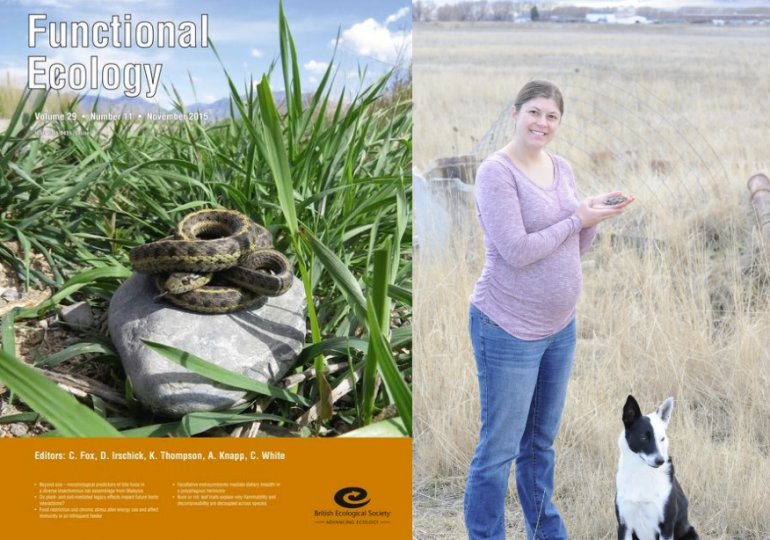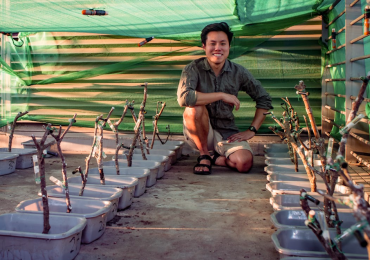Dr. Lori Neuman-Lee, professor at Arkansas State University, discusses the story behind the cover for Volume 29, Issue 11 of Functional Ecology, published all the way back in 2015. Lori is a comparative physiologist. She mostly thinks about reptile ecophysiology at the intersection of endocrinology and immunology. This blog kicks off our brand new blog series – Cover Stories! Read on to learn about one of our amazing cover images, the research behind it, and the people too.
About the Cover Photo
What does your cover photo depict and what research led you to it?
The cover photo is a Wandering Garter snake (Thamnophis elegans) with the Cache Valley, UT in the background. It was surprisingly hard to capture this photo. I had worked for years with this species, but hadn’t taken any cover-worthy images of it. My husband, Nick Kiriazis, is an amateur photographer and we spent a long time trying to get snakes to stay in one place while photographing them. I was wrapping up my dissertation at the time and knew that I wanted to have some good photos of my study organism. This photo was taken when I was in my third trimester with my first child, Nora. Catching snakes was difficult with a pregnant belly, but I still loved being out in the field collecting data.
I had spent the past five years working with this population and other populations of garter snake in Utah. Most of my research focused on the physiological differences among populations over time. Because these populations were experiencing similar environmental factors but had different levels of anthropogenic influence, I was particularly interested in them. While my initial goals were to explore anthropogenic gradients, I ended up learning a lot about the basic physiology of these snakes over the seasons and years. One of the best things about this research was that I got to spend hours in the field on beautiful Utah days catching snakes!
This research was the core of my dissertation work, which has shaped my current research in profound ways. I continue to be intrigued by how physiological systems influence each other. I also learned the value of long-term data sets in biology and in physiology in particular. Physiological responses are always changing due to environmental factors and year-to-year variation provides a lot of complexity to our understanding of how and why things work. I learned that responses common in one population in one year at one season might be exactly different in a different context. But by understanding the varying responses across contexts, we gain a broader and more complete picture of the biology of the animal.
I continued to work in wildlife physiology and spent time thinking about mammalian hormones, particularly during the stress response. I then started a tenure-track position at Arkansas State University. I started my own lab in 2017 and have been continuing to address questions in ecophysiology, focusing mostly on reptiles. I am still firmly rooted in ecological questions, but remain excited about the underlying physiology of an animal. Since the garter snake work, I have become very interested in basic reptilian immunology. We know so little about how the reptilian immune system works. In order to answer my questions of ecology and reptile biology, we need to establish some basic immunological knowledge in reptiles.
Behind The Cover
How did you get involved in Ecology?
I wanted to be a biologist when I was about 6 years old. A graduate student who knew my parents showed me her botany lab and I was hooked. When I started my undergraduate career at Iowa State University, Dr. Fred Janzen fostered my love of ecology with his work with painted turtles. I continued on my own path, linking principles of ecology to physiology.
Have you run into challenges in your career? How did you overcome these?
I came from a rural small town, which meant that going to college to do research was a big leap. I found myself in huge classrooms with people way better prepared than I to be in college. I had to do a lot of navigating academic life by myself and make mistakes because I didn’t even know what questions to ask. That is one reason I work at a university with a high rural population–to help those students navigate college. Another challenge was having kids during my career. I made a decision to not accept postdoc positions in my first year after obtaining my PhD because I had just had a baby and didn’t want to commit to a new project. My second child was born in 2020, which was complicated by the Pandemic. I continued to persevere and relied heavily on my support system–including the amazing graduate student cohort.
Hobbies and proudest achievements?
I have two kids who keep me busy with their lives! I enjoy spending time with them, my partner, and our dog. I love reading and running. I think my proudest achievements now are the published papers of my students. I am certainly proud of my own papers, but it feels amazing to know that I’ve helped guide my students across the finish line of their research.
Any advice for early career researchers?
I would say keep going! Rely on your support system. Do the research you believe in and love. But also make sure to prioritize your own happiness and well-being. It is always a balance of making sure that you are putting the work in and pushing through difficult times while also not pushing yourself too hard.
Leave a comment





